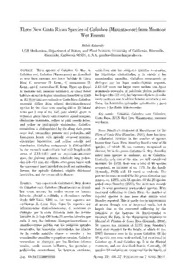
Three New Costa Rican Species of Calathea (Marantaceae) from Montane Wet Forests PDF
Preview Three New Costa Rican Species of Calathea (Marantaceae) from Montane Wet Forests
Three New Costa Rican Species of Calathea (Marantaceae) from Montane Wet Forests Volume 21, Number 1 Kennedy 2011 Calathea (Marantaceae) from Costa Rica to peach-colored basally with apical petaloid portion purplish or dark purplish pink. ca. 22 X 7 mm; 6 Sep. 1972, 1L Kennedy 1558 (BM. CR, DUKE,' INB, MCE US); Bajo La Hondura, 10°04'N, 83°59'W, 8 Sep. 1976, H. H. Kennedy 4585 UR. INB, MO), Paique Nac Biaulio Brauho Carillo, La Montura, along ridge, 25-30 July 1982, C. Todda 1958 (CR). (LC) IUCN Red List criteria (IUCN, it herb, 0.9-1.9 m high, b relatively large (3.2-4 X 4-5.5 cm), p u m confluent. (2.1-)3-8(-9.5) cm; petiole dark green or Volume 21, Number 1 2011 Novon basally grading to yellow near apex, appressed but always with tuft of hairs at very apex (X14 magnification), hairs to 0.5 nun, 17-20 X 2-4 mm; X 4-5 mm; outer staminode broadly elliptic, clawed long in subtending cauline leaf, (39-)104-186(—236) at base, rounded, white, faint yellow to yellow-green, with one side wider than the other, apex off-center, cauline leaf 20-38 cm. others (27-)62-113 Inflorescences 1 to 5 per shoot, the first terminal, subtending leaf, strongly complanate, rectang 11-12.5 X 7-8 mm, crowned by a persistent calyx; 9.2-13 X (3.2-)5.5-8 cm. width substantially let seeds usually 3 per capsule, trigonous, blue, ca. 8.5 X 3.5 X 3.5 mm, bearing a white aril. side. 44-97(—111) cm; bracts 8 to 18. distichous, sis occurs at mid-elevations, front 845 to ca. 1500 nt, refuse, often dying back at apex, 3.8-4.5 X 2.8 3.5 pairs, outer surface of bracts deep olive-green, except thea tarrazuensis should be considered as Data Deficient (DD) according to IUCN Red List criteria (IUCN, 2001), because it is only known from a prophyll firm centrally, thickened along the base of same time lessens the threat. Etymology. The specific epithet, tarrazuensis, apical 1/5 of center back and carina tomentose, glabrous basally, 3.5-3.9 X 1.2-1.3 cm, 0.5-0.8 cm lengtluwidth ratios of 2.13-4.8:1 and an "acuminate- peduncles (44—97[—111] cm), the bracts longer than linear, apex acute, white basally, very tip tinged acute to 90°. white basally^ apex tinged faint 57 o store and study all the M > and use of the 1 comments. C. Niezgoda provided accommodations and ^transport for my stay at F and T. Salvato provided Plantas de Costa R BRIT. CAS. DAV. DH. DUKE. F. INB. MO. NY. PMA. SCZ. SEL. UC. US. and WIS for loan of their specimens and the curators of AAU. CR. GH. MO. UCR. and USJ for the use of their facilities. Thanks
